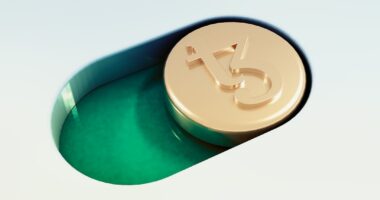Non-fungible tokens (NFTs) have significantly impacted the art world in recent years, transforming the creation, sale, and collection of digital artwork. NFTs are unique digital assets stored on a blockchain, ensuring their individuality and non-interchangeability. Each NFT possesses a distinct value and cannot be duplicated or substituted.
In the art market, NFTs have introduced a novel method for artists to monetize their digital creations while offering collectors the opportunity to own exclusive digital artwork. Traditionally, the art market has been dominated by physical artworks such as paintings and sculptures. However, the emergence of NFTs has expanded opportunities for artists working in the digital realm.
NFTs have enabled digital artists to showcase and sell their work in previously unavailable ways, while also providing collectors with a secure and transparent method of investing in digital art. As the art market continues to evolve, NFTs are expected to play an increasingly significant role in shaping the industry’s future.
Key Takeaways
- NFTs are unique digital assets that represent ownership of a specific item or piece of art, and they are revolutionizing the art market.
- When choosing a platform for NFT art, consider factors such as fees, user base, and the platform’s reputation within the NFT community.
- Creating and digitizing your artwork for NFTs involves ensuring high-quality digital files and potentially using blockchain technology to verify authenticity.
- Minting your NFT art involves uploading your digital file to a platform, adding metadata, and paying a minting fee to create the NFT.
- Setting the price and royalties for your NFT art involves considering factors such as the current market value, the artist’s reputation, and the potential for future resale value.
- Marketing and promoting your NFT art can involve leveraging social media, collaborating with influencers, and participating in NFT art communities to reach potential buyers.
- Managing your NFT art collection involves keeping track of sales, royalties, and potential copyright issues, as well as staying informed about changes in the NFT market.
Choosing the Right Platform for NFT Art
When it comes to selling NFT art, choosing the right platform is crucial for success. There are several popular NFT marketplaces, such as OpenSea, Rarible, and Foundation, that cater to artists looking to mint and sell their digital artwork. Each platform has its own unique features and benefits, so it’s important to research and compare them to find the best fit for your specific needs as an artist.
Consider factors such as fees, user interface, community engagement, and the types of artwork that are popular on each platform. It’s also important to consider the long-term viability and reputation of the platform you choose. Look for platforms that have a strong track record of supporting artists and providing a secure and reliable marketplace for NFT art.
Additionally, consider the platform’s approach to environmental sustainability, as NFTs have come under scrutiny for their potential impact on energy consumption. By carefully evaluating your options and choosing a platform that aligns with your artistic goals and values, you can set yourself up for success in the world of NFT art.
Creating and Digitizing Your Artwork

Creating and digitizing your artwork is a crucial step in the process of selling NFT art. If you’re a traditional artist working with physical mediums, you’ll need to find a way to digitize your artwork in order to mint it as an NFT. This can be done through high-quality scanning or photography, ensuring that the digital representation of your artwork accurately captures its details and nuances.
For digital artists, creating artwork specifically for the NFT market involves using software and tools that are compatible with the requirements of NFT platforms. It’s important to consider the technical specifications and file formats required by the platform you choose, as these can vary from one marketplace to another. Additionally, you may want to consider creating limited edition or exclusive artwork specifically for your NFT releases, adding value and exclusivity to your digital creations.
By taking the time to carefully digitize and prepare your artwork for the NFT market, you can ensure that your pieces are presented in the best possible light and stand out in a crowded marketplace.
Minting Your NFT Art
Minting your NFT art is the process of creating a unique token on a blockchain that represents your digital artwork. This process typically involves uploading your artwork to an NFT marketplace, where it is then tokenized and made available for sale as a one-of-a-kind digital asset. When minting your NFT art, you’ll need to provide details such as the title, description, and any additional information about the artwork that potential buyers may find relevant or interesting.
It’s important to carefully consider how you present and describe your NFT art, as this can greatly impact its appeal to potential collectors. Consider including behind-the-scenes insights into your creative process, the inspiration behind the artwork, or any unique features that make it stand out. Additionally, you may want to consider creating a compelling visual presentation for your NFT art, including high-quality images or videos that showcase the details and intricacies of your digital creations.
By taking the time to mint your NFT art thoughtfully and strategically, you can increase its appeal and attract potential buyers.
Setting the Price and Royalties for Your NFT Art
Setting the price and royalties for your NFT art is an important consideration that can greatly impact your success as an NFT artist. When determining the price of your NFT art, it’s important to consider factors such as the uniqueness of the artwork, its perceived value in the market, and your own artistic reputation and track record. Additionally, consider the current trends and demand for similar types of artwork in the NFT market, as this can help you set a competitive price that reflects the value of your creations.
In addition to setting the initial price of your NFT art, you’ll also need to consider royalties for secondary sales. Royalties ensure that you continue to receive a percentage of the sale price each time your NFT art is resold in the secondary market. This can be an important source of ongoing income for artists, especially as their work gains value over time.
By carefully considering both the initial price and royalties for your NFT art, you can ensure that you are fairly compensated for your creations while also providing value to collectors who invest in your artwork.
Marketing and Promoting Your NFT Art

Marketing and promoting your NFT art is essential for reaching potential buyers and building a strong following in the NFT community. Consider leveraging social media platforms, online communities, and digital art forums to showcase your work and engage with potential collectors. By sharing behind-the-scenes insights into your creative process, offering sneak peeks of upcoming releases, or providing exclusive content to your followers, you can build excitement and anticipation around your NFT art.
Collaborating with other artists or influencers in the NFT space can also be a powerful way to expand your reach and attract new collectors. Consider partnering with like-minded creators on joint releases or collaborations that showcase the unique appeal of your artwork. Additionally, consider participating in virtual events, online exhibitions, or digital art fairs to connect with collectors and enthusiasts who are passionate about NFT art.
By actively marketing and promoting your NFT art, you can increase its visibility and appeal in a competitive marketplace.
Managing Your NFT Art Collection
As an NFT artist, managing your collection of digital artwork is an ongoing process that requires careful attention to detail and organization. Consider keeping detailed records of each piece in your collection, including information such as minting dates, sale prices, royalties earned, and any relevant details about each artwork’s provenance or history. By maintaining thorough records of your NFT art collection, you can track its performance over time and make informed decisions about future releases or marketing strategies.
Additionally, consider engaging with collectors who have invested in your artwork by providing them with exclusive perks or benefits. This could include access to limited edition releases, special events or experiences, or personalized interactions with you as an artist. By nurturing relationships with collectors and providing ongoing value to those who support your work, you can build a loyal fan base and create a sustainable source of income from your NFT art collection.
Overall, managing your NFT art collection requires a combination of strategic planning, attentive record-keeping, and ongoing engagement with collectors to ensure long-term success in the world of digital art.
If you’re exploring the world of NFT art creation, you might also be interested in discovering opportunities within the NFT industry. A great resource for this is NFT Jobs, a platform dedicated to listing job openings in the NFT space. Whether you’re an artist looking to collaborate with tech teams or a marketer wanting to dive into the NFT universe, this site can help you find relevant positions and projects that are seeking creative talents like yours.
FAQs
What is NFT art?
NFT art refers to digital artwork that is tokenized and sold using blockchain technology. Each piece of NFT art is unique and can be bought and sold like any other asset.
How do artists create NFT art?
To create NFT art, artists need to first create a digital artwork using software or other digital tools. They then need to mint the artwork into an NFT using a platform that supports NFT creation, such as OpenSea or Rarible.
What is the process of minting an NFT?
Minting an NFT involves uploading the digital artwork to an NFT marketplace, adding details such as the title, description, and royalties, and then paying a fee to create the NFT. Once minted, the NFT is assigned a unique token ID and becomes part of the blockchain.
How do artists sell their NFT art?
After minting their NFT art, artists can list it for sale on NFT marketplaces such as OpenSea, Foundation, or Nifty Gateway. Buyers can then bid on or purchase the NFT using cryptocurrency.
What are the benefits of creating NFT art?
Creating NFT art allows artists to reach a global audience, receive royalties on secondary sales, and potentially earn higher profits compared to traditional art sales. NFTs also provide a way for artists to authenticate and protect their digital artwork.





